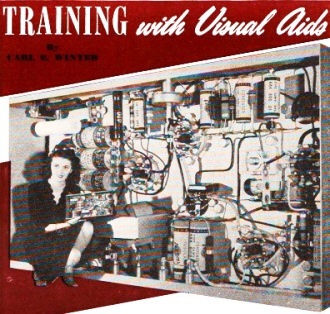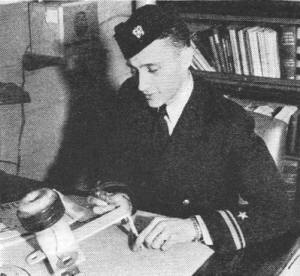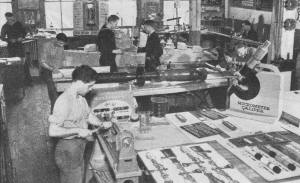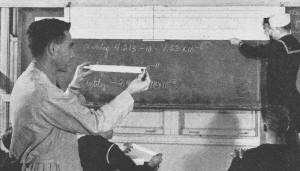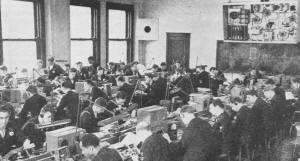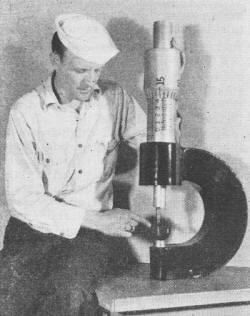Training with Visual Aids |
||
Long before there was Power Point (OpenOffice's Impress is the free equivalent), presentations at training seminars were conducted using overhead projectors and larger-than-life props of the devices being taught. The U.S. Navy, during World War II, set up a special facility called the Visual Aid Model Shop located at Radio Chicago, Chicago, Illinois. Its charter was to design and build very large scale models of equipment and tools that service personnel used while performing their duties. It is kind of funny to look at the sizes of some of the items, like the 8x size radio chassis assembly shown in this article's main photograph. As a life-long model builder myself, I would have loved to work in a shop like that building torso-size electrolytic capacitors and potentiometer bodies as large as dinner plates. The closest I ever got to it professionally was while working at Westinghouse Oceanic Division (now Northrop Grumman) in Annapolis, Maryland, as a technician building prototype electronics and mechanical products. One of the bummers of earning my BSEE degree was having to relegate that kind of work to techs because my employers thought they were paying me too much to do it myself. Training with Visual Aids Miss Hazel Fox, civilian employee of Ship's Service at Radio Chicago, holds normal sized receiver for comparison with the giant instructional model made by Visual Aids Department. Instructional techniques used by the Navy to train their radio and radar repairmen can be used by civilian schools. Radio Chicago, the primary school of the U. S. Navy's Radio Technician Training Program, is doing a big and important job in the training of men to repair and maintain radar equipment, radio direction finders, u.h.f. equipment, and other such devices. When these men complete their radio technician training less than one year after entering the program, they are radio and radar technicians qualified to keep many types of the Navy's electronic equipment operating at top efficiency. The thoroughness of the Navy training is, in itself, almost as great a scientific wonder as the marvelous equipment with which the students work. To assemble a conglomeration of men of all ages and backgrounds, possessing varying degrees of aptitude and general knowledge, put them through schooling comparable to some collegiate science courses, and within a year bring them to a mutual level of ability as highly skilled technicians in a field as abstractly theoretical as electronics, indeed requires a scientific approach. If anyone method of instruction can claim credit for the rapid development of these potential radio technicians, that method would be the extensive visual aid program which is a vital adjunct to the teaching techniques used at these radio schools. The training given radio technicians deals only with material associated with the theory and practice of radio and radar maintenance. This fact alone streamlines and differentiates the course from college engineering curricula, and the use of visual aids in presenting theory and practice to the student has been found to be of invaluable assistance in the transmission of new knowledge. Lt. (j.g.) A. L. Rogers. W9OZE, Visual Aids Officer of Radio Chicago, holds a normal sized coil for comparison with the instructional coil made by visual aids. Over-all view of the Visual Aid Model Shop located at Radio Chicago, Chicago, Illinois. In this shop are built all of the visual aids used to teach radio trainees. The principles of using the slide rule are taught by means of a quant model while students make computations on their individual rules. Chief Radio Technician E. J. Tripler of Montrose, Colorado. is instructing the class on the small slide rule while the model on the wall is being set by Charles Barrett, Specialist (X) 3/C, of Deland, Florida, a member of the Visual Aids Department for Radio Chicago. Laboratory where students are building five-tube superheterodynes as one of their projects before graduation. Note the large scale model of the receiver mounted on the wall for the guidance of the students in placing parts. The results which have been achieved by means of visual aids in the field of adult education have aroused the interest of educators throughout the country. The Radio Technician Training Program, as it is set up today, involves several educational helps which are of interest to the layman and educator alike. The first step in the program requires that the applicant for radio technician training successfully pass the special aptitude test which is designed to select only those best qualified and most likely to complete the prescribed course. This pre-selection of the students is accomplished by means of the well-known "Eddy Test". This test which was devised and developed by Captain William C. Eddy is not a measure of man's technical or mechanical, background, but it does preclude a better-than-average working knowledge of high school mathematics and physics. While these two subjects receive the primary emphasis in the examination, it is also necessary for the applicant to understand certain phases of general science, shop practice, elementary electricity, and radio. The "Eddy Test" is roughly divided into five categories covering approximately 80 questions on mathematics, physics, shop practice, electricity, and radio. In the field of mathematics, it is necessary for the applicant to be able to perform simple mathematical operations such as cancellations, division, multiplication, addition of algebraic fractions, square roots, percentages, equations and logarithms, etc. The part of the test covering physics requires a working knowledge of heat, light, magnetism, sound, and other phases of general science. Shop practice covers the use of various tools including micrometers, hand tools, the reading of shop drawings, the correct use of files, screws, bolts. soldering irons, etc. The requirements for electricity and radio cover Ohm's Law, direct current circuits, elements of alternating current theory, basic receiver principles, vacuum tubes, and circuit components. The test breaks down into 40% mathematics, 20% basic physics, 15% basic electricity, 15% basic radio, and 10% shop practice. The grades received by the students in these tests are entered as part of their Navy record and these records have resulted in a careful study of case histories and several revisions in the "Eddy Test", but basically the test remains about the same as it was at the time of its adoption in the early part of 1942. Upon the successful completion of the "Eddy Test" and providing the candidate meets all of the physical and other requirements of the Navy, the student is sent to "boot" training where he must first of all become a sailor before he becomes a specialist. In boot training the student learns how to sling a hammock, how to tell port from starboard, and, in general, become a sailor. During this period, which lasts from five to twelve weeks, he can talk radio and dream radar to his heart's content but nary a radio tube or textbook does the candidate see. Upon completion of "boot" training, the candidate enters pre-radio school, where during a month's course of intensive study he reviews high school algebra, learns the elements of electricity and the fundamentals of shop practices by means of lectures and laboratory classwork. In this school the student is first introduced to the visual aid "method of instruction. The use of the slide rule is taught by means of a giant nine-foot model of its familiar counterpart. This model is constructed to scale and is capable of being operated by the instructor. Problems worked by means of the slide rule are illustrated by the instructor, who makes the proper setting on the large scale model and the class then performs the proper operation on their individual rules. In a similar manner, recognition of tools and the proper use of various shop equipment is taught. Sharpening of bits and twist drills becomes easier for the student because giant models of the grinding operation and cutting surfaces of the tools are available for comparison. Thus, when the student completes his work at the pre-radio school, he is already familiar with many of the visual aids which he will meet time and again in primary and secondary schools. In the Primary schools, the student begins his work on radio equipment and associated test equipment in earnest. Each student, before his graduation from the primary school, is required to construct a complete five-tube superheterodyne receiver. The proper placement of parts and the general layout of the chassis are taught by means of a giant receiver which is exactly scaled to the original. The theory of radio operation is also taught by means of this gigantic receiver, which is large enough for a six-foot man to move around in comfortably. In the courses in shop practice, the correct use of soldering irons, micrometers, and hand tools are continued at a high level by means of large scale models of each of these instruments. In specific instances, the use of visual aids has cut the training time in almost unbelievable amounts. In one experiment involving the installation of an octal tube socket in a chassis and the soldering of wire leads from a resistor network to certain socket prongs, fifty-five minutes were lopped off the instruction time by the use of a visual aid. Before the adoption of this instruction technique, it was the practice of the instructor to lecture to the students for a one-hour period on the correct practices involved in performing this operation. By means of the oversized model constructed by the Visual Aids Department, the lecture time was cut to a five minute preliminary outlining of the problem to be done. Jack Phillips, Specialist (X) 1/C of Long Island, New York, demonstrates the large sized micrometer used for instructional purposes. The normal sized unit is shown for comparison. The Du Mont twenty-inch oscilloscope is being used by Chief Ernest Sindelar. Chief Instructor of Radio Chicago, to instruct Charles O. Whitehead, Radio Technician 2/C, of Columbus, Mississippi, on correct operating procedure. In similarly dramatic fashion, the operation of the oscilloscope and correct interpretation of patterns on its screen is taught to the students by means. of a 20" oscilloscope which is easily visible to the entire class during the instructor's lecture-demonstration. Since most of the features of the more readily portable units are incorporated on this demonstration 'scope, the class is thoroughly familiar with the operation of all the controls when he begins work on the oscilloscope projects. The testing of meters, which has always been considered an extremely difficult subject to teach to groups because of the small size of most meter parts, has been facilitated by means of model meters which are built eight times normal size. Every detail down to the last coil turn is duplicated faithfully by the model makers. In addition to individual pieces of equipment, the student becomes familiar with several other types of visual aids during his course of study. Circuits of various pieces of equipment are "blown up" and built onto a demonstration board. In some working models the operation of a receiver may be demonstrated and the signal traced through the circuit by means of electrically operated indicating devices. Various types of tubes, both receiving and transmitting become familiar to the student because actual tubes are mounted on demonstration panels for his inspection. In addition to this familiarization process, the Visual Aids Department builds giant stripped-down models of the internal construction of the tube showing all working parts, without the glass envelope in place. Students are taught correct procedures for maintaining and servicing soldering irons from this giant model being supported by Francis Mair, Specialist (X) 1/C of Streatorville, Illinois, Mr. Mair is the head of the Visual Aids Department of Radio Chicago. Great care goes into the construction of each unit turned out by the visual aids group so that every feature of the model closely resembles or duplicates the characteristics of the original, including solder joints, etc. The great majority of the visual aids in use at Radio Chicago have been the handiwork of the Visual Aids Department connected with the school. From a small beginning in November of 1942, when the first artist was assigned to the school, this department has expanded until today it is a full-fledged organization working full-time on the job of preparing training aids for the Navy. The pioneer artist, upon whom rested the responsibility of organizing the work, was Chief Specialist (X) Brander, who is now a lieutenant stationed at the Bureau of Personnel, Training Division, in Washington, D.C. By January, 1943, this department had grown to three staff artists and model makers who devoted their entire time to producing training aids for the rapidly expanding radio school. Today this department keeps twelve Navy men busy full-time preparing the various material for classroom instruction. A completely equipped workshop permits independent operation of the department. Many types of materials are used in the construction of the models, including plastics, wood, plywood, sheet steel, and non-priority material. The work of this department is now under the direction of Lt. (j.g.) A. L. Rogers, a peace-time radio amateur from Waukegan, Illinois. In addition to the models used for training, the Navy is also a staunch champion of the efficacy of motion pictures and slide films in training operations. A Training Aids Library was set up at 1212 North Lake Shore Drive, Chicago, for the purpose of supplying films and projectors to supplement the visual aids. By Navy contract, Burton Holmes Films, Inc. produced a 16 mm. sound movie in the laboratories of Radio Chicago entitled "Radio Technician Shop Practice". Upon completion of this standard 40 minute film, 3 more 16 mm. sound films and about 20 slide films (35 mm.) were produced in a similar manner under the supervision of Navy instructors at Radio Chicago. Thus in several different forms, the Navy is making use of various time-saving visual aids in the instruction of their radio technicians. It seems certain that in the postwar era, schools and colleges will be quick to take advantage of what the Navy has learned laboriously. When students from all walks of life are brought together to learn the intricacies of any science or abstract subject, new and disassociated ideas must be presented to them in a simplified, easily grasped manner if utmost speed of instruction and intelligent comprehension is to be obtained. Visual aids have proved to be the ideal medium to achieve this end, for it is this method that has enabled Radio Chicago to prepare untrained naval personnel for the exacting task of maintaining the complex electronic equipment which is the voice, eyes, and ears of the U. S. Navy.
Posted July 25, 2022 |
||

